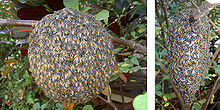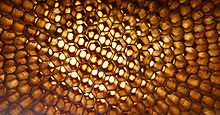- Apis florea
-
Apis florea 
Worker Scientific classification Kingdom: Animalia Phylum: Arthropoda Class: Insecta Order: Hymenoptera Family: Apidae Genus: Apis Subgenus: (Micrapis) Species: A. florea Binomial name Apis florea
Fabricius, 1787Apis florea nest, Thailand. The nest is 20&n bsp;cm in diameter and contains approximately 3600 cells on each side. The reflective substance on the branch either side of the nest is propolis which acts as a sticky and chemically repellent barrier to protect the nest from ants, particularly weaver ants (Oecophylla smaragdina).[1] The curtain of bees covering the comb is 3–4 bees thick (~10 mm).
The dwarf honey bee or the red dwarf honey bee, Apis florea, is one of two species of small, wild honey bees of southern and southeastern Asia. It has a much wider distribution than its sister species, Apis andreniformis.
This together with A. florea is the most plesiomorphic honeybee species alive. Separating roughly about the Bartonian (some 40 mya or slightly later) from the other lineages, among themselves they do not seem to have diverged a long time before the Neogene.[2]
These two species together comprise the subgenus Micrapis, and are the most primitive of the living species of Apis, reflected in their small colony size, and simple nest construction. The exposed single combs are built on branches of shrubs and small trees. The forager bees do not perform a gravity oriented waggle dance on the vertical face of the comb to recruit nestmates as in the domesticated Apis mellifera and other species. Instead they perform the dance on the horizontal upper surface where the comb wraps around the supporting branch. The dance is a straight run pointing directly to the source of pollen or nectar that the forager has been visiting. In all other Apis species, the comb on which foragers dance is vertical, and the dance is not actually directed towards the food source.
Both the bees were generally identified as Apis florae, and most information still relates to this species prior to the 1990s. However, the distinctiveness of the two species Apis florea and Apis andreniformis was established unequivocally in the 1990s. Apis florea is redder and the first abdomen is always red in an old worker (younger workers are paler in colour, as is the case in giant honey bees); Apis andreniformis is in general darker and the first abdomen segment is totally black in old bees.[3]
Ecology
Aside from their small size, simple exposed nests, and simplified dance language, the life cycle and behaviour of this species is fairly similar to other species of Apis.
Parasites
The main parasites of both A. andreniformis and A. florea belong to genus Euvarroa. However, A. andreniformis is attacked by the species Euvarroa wongsirii, while Euvarroa sinhai preys on A. florea and colonies of Apis mellifera that are imported. The two species of Euvarroa have morphological and biological differences: while E. wongsirii has a triangular body shape and a length of 47–54 μm (micrometres), E. sinhai has a more circular shape and a length of 39–40 μm.
References
- ^ Duangphakdee, Orawan; Nikolaus Koenigerb, Gudrun Koenigerb, Siriwat Wongsiria and Sureerat Deowanish (October-December 2005). "Reinforcing a barrier – a specific social defense of the dwarf honeybee (Apis florea) released by the weaver ant (Oecophylla smaragdina)". Apidologie 36 (4): 505–511. doi:10.1051/apido:2005036. http://www.culturaapicola.com.ar/apuntes/revistaselectronicas/Bienenkunde/2005/10.pdf.
- ^ Maria C. Arias & Walter S. Sheppard (2005). "Phylogenetic relationships of honey bees (Hymenoptera:Apinae:Apini) inferred from nuclear and mitochondrial DNA sequence data". Molecular Phylogenetics and Evolution 37 (1): 25–35. doi:10.1016/j.ympev.2005.02.017. PMID 16182149.
Maria C. Arias & Walter S. Sheppard (2005). "Corrigendum to “Phylogenetic relationships of honey bees (Hymenoptera:Apinae:Apini) inferred from nuclear and mitochondrial DNA sequence data” [Mol. Phylogenet. Evol. 37 (2005) 25–35]". Molecular Phylogenetics and Evolution 40 (1): 315. doi:10.1016/j.ympev.2006.02.002. - ^ Y. R. Wu & B. Kuang (1987). "Two species of small honeybee - a study of the genus Micrapis". Bee World 68: 153–155.
Categories:- Apis (genus)
- Animals described in 1787
Wikimedia Foundation. 2010.


